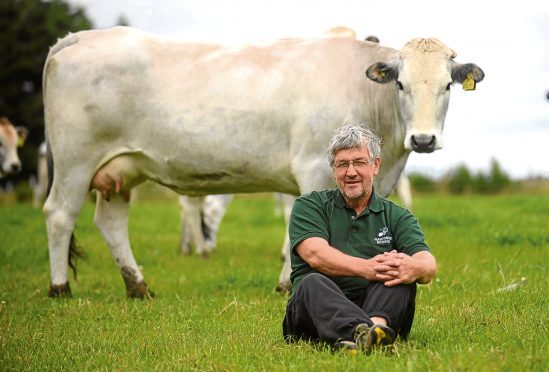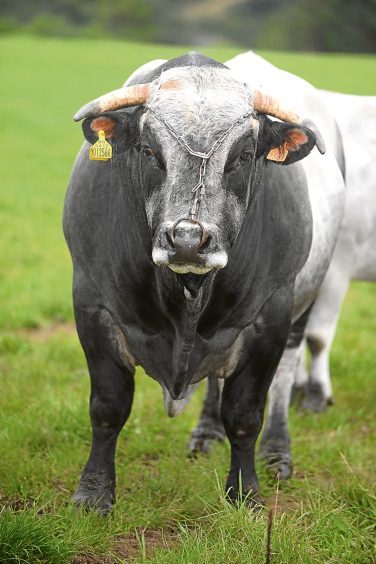When Willie Hendry went to Thainstone livestock market to research the price of calves, he had little idea that he’d be coming home with a thought about how to revolutionise his beef business.
Rearing 120 store cattle on grassland on his 198-acre farm at Longmorn, Elgin, Willie was struggling to make a profit, and he knew he would have to make some changes to his farm.
“We always bought heifers, and when one came through in-calf I didn’t have a clue what to sell it for, so I went to the market to gauge prices. That’s where I first saw the Gascon cattle,” said Mr Hendry.
“It was a heifer which was small and had obviously been bulled a bit early, but the calf was tremendous – it caught my attention.”
After searching for the breed on Google when he got home, he contacted the secretary of the Gascon Cattle Society, who told him that a farmer in the society was retiring and wanted to sell his herd.
“From going to sell a cow in-calf I ended up with seven cows and followers and two young heifers,” said Mr Hendry.
His purchasing didn’t stop there though.
After being introduced to the retired farmer’s neighbour – who also farmed the breed – he bought some bullocks to test how well they would fatten on his farm.
“The experiment of taking the bullock showed me how versatile they were,” said Mr Hendry. “They had come from 4,000 acres of hill land, and their response to grass was tremendous.
“They have a very impressive feed conversion ratio, making them very economical to feed. We were previously buying in seven tonnes of feed barley every two or three weeks to feed the cattle.
“With the Gascons that amount has halved. We’re feeding bullocks on silage with around 2kg of barley per day, and they’re in wonderful condition.”
But it’s not just the feed conversion ratio which made the breed appeal to Willie.
First reared in the French Pyrenees – making them adaptable to tough climates like those in Scotland – there are around 40,000 Gascon cattle reared by 200 Groupe Gascon members across France, where farmers favour the breed for their ability to cope in harsh hill systems and their easy-calving ability.
According to figures from the French Gascon breeders society, cesarean rates for the breed are 1%, while veterinary costs are the lowest level for any breed of cattle – traits which suits Willie’s business perfectively.
“We moved from an extensive to a more intensive system, because we found that the cattle were capable of reaching their finishing weight between 20-24 months,” said Mr Hendry.
“They calve very easily – we have had 100% calving for the last two years – they have a fantastic temperament and they lend themselves to our system.
“We are also potato merchants and have delivery commitments on a daily basis, so the fact they are resilient means they dovetail into our business really well.”
Moving from finishing cattle to producing his own might have been a challenge with some breeds, but Mr Hendry says the change was made simple by the versatility of the Gascons.
Calves are born at 36-38kg, with the bull calves weighing in at 40-42kg.
Bull calves are finished to 16 months, when they are sent to slaughter at 420kg, while finishing cattle are slaughtered at 24 months at 390-400kg deadweight.
Mothers return to bull quickly, averaging 1.1 calves a year, giving the herd added longevity.
“They can be outwintered in the hills without any issues,” said Mr Hendry.
“We calve indoors for easier management, but afterwards they of outside in February and they are quite happy.
“Before we were struggling to finish cattle that we were buying-in as stores at 30 months, whereas now we are putting these cattle away six months earlier. What’s more, we’re using less inputs and we’re hitting U grades, which we never did before.”
In future Mr Hendry plans to continue breeding stock, adding to the UK’s Gascon population of 550 cattle and selling animals to new producers through the Gascon society, of which he is vice-chairman.
He is also making use of genotyping to produce bulls with the myostatin, or double-muscling gene.
Mr Hendry hopes that through breeding, he will be able to make use of the gene to produce slightly larger, more commercially-appealing stock which are still easy to calve.
“First and foremost we are a commercial unit, and as such we need to add more to the back end. Over three calvings though we are seeing the influence we want to achieve,” said Mr Hendry.
“Everyone’s first reaction is that they’ve never heard of them or seen them before, and it’s like they’ve slipped under the radar. They might not be the complete answer, but they certainly tick a lot of the boxes for us, and I couldn’t imagine life without them now.”

